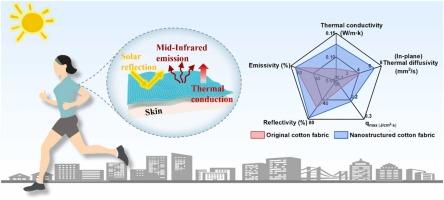当前位置:
X-MOL 学术
›
Ind. Crops Prod.
›
论文详情
Our official English website, www.x-mol.net, welcomes your
feedback! (Note: you will need to create a separate account there.)
Nanostructured cotton fabrics for personal passive cooling with enhanced thermal conduction and energy saving
Industrial Crops and Products ( IF 5.6 ) Pub Date : 2024-10-20 , DOI: 10.1016/j.indcrop.2024.119884 Yuanxiang Xiao, Feiyang Zhao, Yang Lu, Xi Liu, Shuangfei Xiang, Shujun Zhao, Feiya Fu, Xiangdong Liu
Industrial Crops and Products ( IF 5.6 ) Pub Date : 2024-10-20 , DOI: 10.1016/j.indcrop.2024.119884 Yuanxiang Xiao, Feiyang Zhao, Yang Lu, Xi Liu, Shuangfei Xiang, Shujun Zhao, Feiya Fu, Xiangdong Liu

|
Textiles with passive cooling capabilities offer an efficient way to optimize personal thermal regulation. However, the simultaneous achievement of passive cooling, durability, and comfort in a single fabric poses a significant challenge. Herein, an ingenious cotton fabric that can be fabricated through a facile dip-dry technique is proposed. Carboxylated cellulose nanocrystals are grafted onto the fiber surfaces, and then covalently linked with hydroxylated boron nitride nanosheets to form a nanostructured coating. The resulting fabric demonstrates a remarkable enhancement of 69 % in its thermal conductivity and an impressive 56 % rise in in-plane thermal diffusivity, when compared to the pristine cotton fabric. This has the potential to raise the comfort setpoint temperature of indoor cooling equipment by 2.1 °C, thereby reducing cooling energy consumption by 22.2 %, while significantly enhancing the perceived cooling effect on the skin. Under the direct sunlight, the nanostructured fabric cools the skin by 1.21 °C below ambient temperature, preventing an excessive increase of 8.2 °C in skin temperature. Moreover, the resulting fabric maintains comparable levels of comfort and wearability as that of the original cotton fabric. This study presents an innovative strategy towards the development of passive cooling textiles.
中文翻译:

用于个人被动冷却的纳米结构棉织物,具有增强的导热和节能效果
具有被动冷却功能的纺织品提供了一种优化个人热调节的有效方法。然而,在单一织物中同时实现被动冷却、耐用性和舒适性是一项重大挑战。在此,提出了一种可以通过简单的浸干技术制成的巧妙棉织物。羧化纤维素纳米晶体接枝到纤维表面,然后与羟基化氮化硼纳米片共价连接,形成纳米结构涂层。与原始棉织物相比,所得织物的导热性显著提高了 69%,面内热扩散率提高了 56%,令人印象深刻。这有可能将室内冷却设备的舒适设定点温度提高 2.1 °C,从而将冷却能耗降低 22.2%,同时显着增强对皮肤的感知冷却效果。在阳光直射下,纳米结构织物使皮肤温度比环境温度低 1.21 °C,防止皮肤温度过度升高 8.2 °C。此外,所得织物的舒适度和耐磨性与原始棉织物相当。本研究提出了一种开发被动冷却纺织品的创新策略。
更新日期:2024-10-20
中文翻译:

用于个人被动冷却的纳米结构棉织物,具有增强的导热和节能效果
具有被动冷却功能的纺织品提供了一种优化个人热调节的有效方法。然而,在单一织物中同时实现被动冷却、耐用性和舒适性是一项重大挑战。在此,提出了一种可以通过简单的浸干技术制成的巧妙棉织物。羧化纤维素纳米晶体接枝到纤维表面,然后与羟基化氮化硼纳米片共价连接,形成纳米结构涂层。与原始棉织物相比,所得织物的导热性显著提高了 69%,面内热扩散率提高了 56%,令人印象深刻。这有可能将室内冷却设备的舒适设定点温度提高 2.1 °C,从而将冷却能耗降低 22.2%,同时显着增强对皮肤的感知冷却效果。在阳光直射下,纳米结构织物使皮肤温度比环境温度低 1.21 °C,防止皮肤温度过度升高 8.2 °C。此外,所得织物的舒适度和耐磨性与原始棉织物相当。本研究提出了一种开发被动冷却纺织品的创新策略。


















































 京公网安备 11010802027423号
京公网安备 11010802027423号